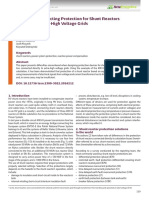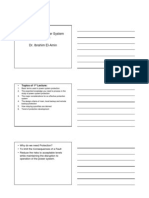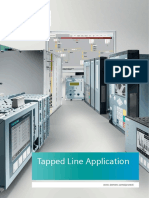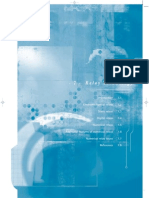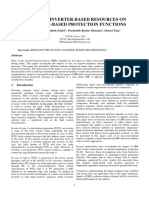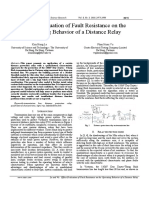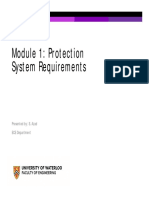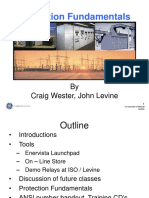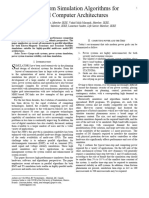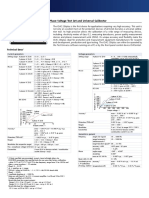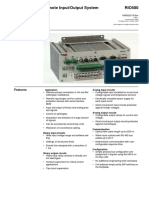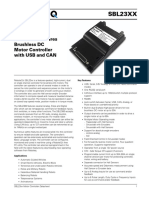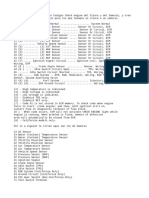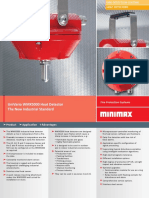Protection Basics
Presented by
John S. Levine, P.E.
Levine Lectronics and Lectric, Inc.
770 565-1556
John@L-3.com
1
GE Consumer & Industrial
Multilin
�Protection Fundamentals
By
John Levine
2
GE Consumer & Industrial
Multilin
�Outline
Introductions
Tools
Enervista Launchpad
On Line Store
Demo Relays at Levine
ANSI number
Training CDs
Protection Fundamentals
3
GE Consumer & Industrial
Multilin
�Objective
We are here to help make your job easier.
This is very informal and designed around
Applications. Please ask question. We
are not here to preach to you.
The knowledge base in the room varies
greatly. If you have a question, there is a
good chance there are 3 or 4 other people
that have the same question. Please ask
it.
4
GE Consumer & Industrial
Multilin
�Tools
5
GE Consumer & Industrial
Multilin
�6
GE Consumer & Industrial
Multilin
�Demo Relays at L-3
7
GE Consumer & Industrial
Multilin
�Relays at L-3
8
GE Consumer & Industrial
Multilin
�9
GE Consumer & Industrial
Multilin
�GE Multilin Training CDs
10
GE Consumer & Industrial
Multilin
�ANSI Symbols
11
GE Consumer & Industrial
Multilin
�Conversion of Electro-Mechanical
to Electronic sheet
12
GE Consumer & Industrial
Multilin
�PowerPoint presentations at:
http://l-3.com/private/ieee/
13
GE Consumer & Industrial
Multilin
�Protection Fundamentals
14
GE Consumer & Industrial
Multilin
�Desirable Protection Attributes
Reliability: System operate properly
Security: Dont trip when you shouldnt
Dependability: Trip when you should
Selectivity: Trip the minimal amount to clear the
fault or abnormal operating condition
Speed: Usually the faster the better in terms of
minimizing equipment damage and maintaining
system integrity
Simplicity: KISS
Economics: Dont break the bank
15
GE Consumer & Industrial
Multilin
�Art & Science of Protection
Selection of protective relays requires compromises:
Maximum and Reliable protection at minimum
equipment cost
High Sensitivity to faults and insensitivity to maximum
load currents
High-speed fault clearance with correct selectivity
Selectivity in isolating small faulty area
Ability to operate correctly under all predictable power
system conditions
16
GE Consumer & Industrial
Multilin
�Art & Science of Protection
Cost of protective relays should be balanced
against risks involved if protection is not
sufficient and not enough redundancy.
Primary objectives is to have faulted zones
primary protection operate first, but if there are
protective relays failures, some form of
backup protection is provided.
Backup protection is local (if local primary
protection fails to clear fault) and remote (if
remote protection fails to operate to clear
fault)
17
GE Consumer & Industrial
Multilin
�Primary Equipment & Components
Transformers - to step up or step down voltage level
Breakers - to energize equipment and interrupt fault current
to isolate faulted equipment
Insulators - to insulate equipment from ground and other
phases
Isolators (switches) - to create a visible and permanent
isolation of primary equipment for maintenance purposes
and route power flow over certain buses.
Bus - to allow multiple connections (feeders) to the same
source of power (transformer).
18
GE Consumer & Industrial
Multilin
�Primary Equipment & Components
Grounding - to operate and maintain equipment safely
Arrester - to protect primary equipment of sudden
overvoltage (lightning strike).
Switchgear integrated components to switch, protect,
meter and control power flow
Reactors - to limit fault current (series) or compensate for
charge current (shunt)
VT and CT - to measure primary current and voltage and
supply scaled down values to P&C, metering, SCADA, etc.
Regulators - voltage, current, VAR, phase angle, etc.
19
GE Consumer & Industrial
Multilin
�Types of Protection
Overcurrent
Uses current to determine magnitude of fault
Simple
May employ definite time or inverse time curves
May be slow
Selectivity at the cost of speed (coordination stacks)
Inexpensive
May use various polarizing voltages or ground current
for directionality
Communication aided schemes make more selective
20
GE Consumer & Industrial
Multilin
�Instantaneous Overcurrent Protection (IOC) &
Definite Time Overcurrent
Relay closest to fault operates
first
Relays closer to source
operate slower
Time between operating for
same current is called CTI
(Clearing Time Interval)
Distribution
Substation
21
GE Consumer & Industrial
Multilin
�(TOC) Coordination
Relay closest to fault operates
first
Relays closer to source
operate slower
Time between operating for
same current is called CTI
Distribution
Substation
22
GE Consumer & Industrial
Multilin
�Time Overcurrent Protection (TOC)
Selection of the curves
uses what is termed as a
time multiplier or
time dial to effectively
shift the curve up or
down on the time axis
Operate region lies
above selected curve,
while no-operate region
lies below it
Inverse curves can
approximate fuse curve
shapes
23
GE Consumer & Industrial
Multilin
�Time Overcurrent Protection
(51, 51N, 51G)
Multiples of pick-up
24
GE Consumer & Industrial
Multilin
�Types of Protection
Differential
current in = current out
Simple
Very fast
Very defined clearing area
Expensive
Practical distance limitations
Line differential systems overcome this using
digital communications
26
GE Consumer & Industrial
Multilin
�Differential
Note CT polarity
dots
This is a
through-current
representation
Perfect
waveforms, no
saturation
27
GE Consumer & Industrial
Multilin
�Differential
Note CT
polarity dots
This is an
internal fault
representation
Perfect
waveforms, no
saturation
28
GE Consumer & Industrial
Multilin
�Types of Protection
Voltage
Uses voltage to infer fault or abnormal
condition
May employ definite time or inverse time
curves
May also be used for undervoltage load
shedding
Simple
May be slow
Selectivity at the cost of speed (coordination
stacks)
Inexpensive
29
GE Consumer & Industrial
Multilin
�Types of Protection
Frequency
Uses frequency of voltage to detect power
balance condition
May employ definite time or inverse time
curves
Used for load shedding & machinery
under/overspeed protection
Simple
May be slow
Selectivity at the cost of speed can be expensive
30
GE Consumer & Industrial
Multilin
�Types of Protection
Power
Uses voltage and current to determine
power flow magnitude and direction
Typically definite time
Complex
May be slow
Accuracy important for many applications
Can be expensive
31
GE Consumer & Industrial
Multilin
�Types of Protection
Distance (Impedance)
Uses voltage and current to determine impedance of
fault
Set on impedance [R-X] plane
Uses definite time
Impedance related to distance from relay
Complicated
Fast
Somewhat defined clearing area with reasonable
accuracy
Expensive
Communication aided schemes make more selective
32
GE Consumer & Industrial
Multilin
Impedance
ZL
Relay in Zone 1 operates first
Time between Zones is called
CTI
R
ZB
T2
ZA
T1
21
21
Source
33
GE Consumer & Industrial
Multilin
�Generation-typically at 4-20kV
Transmission-typically at 230-765kV
Typical
Bulk
Power
System
Receives power from transmission system and
transforms into subtransmission level
Subtransmission-typically at 69-161kV
Receives power from subtransmission system
and transforms into primary feeder voltage
Distribution network-typically 2.4-69kV
Low voltage (service)-typically 120-600V
36
GE Consumer & Industrial
Multilin
�Protection Zones
1. Generator or Generator-Transformer Units
2. Transformers
3. Buses
4. Lines (transmission and distribution)
5. Utilization equipment (motors, static loads, etc.)
6. Capacitor or reactor (when separately protected)
Bus zone
Unit Generator-Tx zone
Bus zone
Line zone
Bus zone
Motor zone
Transformer zone
Transformer zone
~
Generator
XFMR
Bus
Line
Bus
XFMR
Bus
Motor
37
GE Consumer & Industrial
Multilin
�Zone Overlap
1.
Overlap is accomplished by the locations of CTs, the key source for
protective relays.
2.
In some cases a fault might involve a CT or a circuit breaker itself, which
means it can not be cleared until adjacent breakers (local or remote) are
opened.
Relay Zone A
Zone A
Relay Zone B
Relay Zone A
Zone B
Zone A
Relay Zone B
Zone B
CTs are located at both sides of CB-
CTs are located at one side of CB-
fault between CTs is cleared from both remote
sides
fault between CTs is sensed by both relays,
remote right side operate only.
38
GE Consumer & Industrial
Multilin
�What Info is Required to Apply Protection
1. One-line diagram of the system or area involved
2. Impedances and connections of power equipment, system
frequency, voltage level and phase sequence
3. Existing schemes
4. Operating procedures and practices affecting protection
5. Importance of protection required and maximum allowed
clearance times
6. System fault studies
7. Maximum load and system swing limits
8. CTs and VTs locations, connections and ratios
9. Future expansion expectance
10. Any special considerations for application.
43
GE Consumer & Industrial
Multilin
�C37.2:
Device
Numbers
Partial listing
44
GE Consumer & Industrial
Multilin
�One Line Diagram
Non-dimensioned diagram showing how
pieces of electrical equipment are
connected
Simplification of actual system
Equipment is shown as boxes, circles and
other simple graphic symbols
Symbols should follow ANSI or IEC
conventions
45
GE Consumer & Industrial
Multilin
�1-Line Symbols [1]
46
GE Consumer & Industrial
Multilin
�1-Line Symbols [2]
47
GE Consumer & Industrial
Multilin
�1-Line Symbols [3]
48
GE Consumer & Industrial
Multilin
�1-Line Symbols [4]
49
GE Consumer & Industrial
Multilin
�1-Line [1]
50
GE Consumer & Industrial
Multilin
�1-Line [2]
�3-Line
52
GE Consumer & Industrial
Multilin
�CB Trip Circuit (Simplified)
55
GE Consumer & Industrial
Multilin
�Lock Out Relay
PR
86b
86
TC
86a
86b
Shown in RESET position
58
GE Consumer & Industrial
Multilin
�CB Coil Circuit Monitoring:
T with CB Closed; C with CB Opened
59
GE Consumer & Industrial
Multilin
�CB Coil Circuit Monitoring:
Both T&C Regardless of CB state
60
GE Consumer & Industrial
Multilin
�Current Transformers
Current transformers are used to step primary system currents
to values usable by relays, meters, SCADA, transducers, etc.
CT ratios are expressed as primary to secondary; 2000:5, 1200:5,
600:5, 300:5
A 2000:5 CT has a CTR of 400
61
GE Consumer & Industrial
Multilin
�Standard IEEE CT Relay
Accuracy
IEEE relay class is defined in terms of the voltage a CT
can deliver at 20 times the nominal current rating
without exceeding a 10% composite ratio error.
For example, a relay class of C100 on a 1200:5 CT means that
the CT can develop 100 volts at 24,000 primary amps
(1200*20) without exceeding a 10% ratio error. Maximum
burden = 1 ohm.
100 V = 20 * 5 * (1ohm)
200 V = 20 * 5 * (2 ohms)
400 V = 20 * 5 * (4 ohms)
800 V = 20 * 5 * (8 ohms)
62
GE Consumer & Industrial
Multilin
�Standard IEEE CT Burdens (5 Amp)
(Per IEEE Std. C57.13-1993)
64
GE Consumer & Industrial
Multilin
�Voltage Transformers
Voltage (potential) transformers are used to isolate and step
down and accurately reproduce the scaled voltage for the
protective device or relay
VT ratios are typically expressed as primary to secondary;
14400:120, 7200:120
A 4160:120 VT has a VTR of 34.66
VP
VS
Relay
66
GE Consumer & Industrial
Multilin
�Typical CT/VT Circuits
Courtesy of Blackburn, Protective Relay: Principles and Applications
67
GE Consumer & Industrial
Multilin
�CT/VT Circuit vs. Casing Ground
Case
Secondary Circuit
Case ground made at IT location
Secondary circuit ground made at first point of
use
68
GE Consumer & Industrial
Multilin
�Equipment Grounding
Prevents shock exposure of personnel
Provides current carrying capability for the
ground-fault current
Grounding includes design and construction of
substation ground mat and CT and VT safety
grounding
69
GE Consumer & Industrial
Multilin
�System Grounding
Limits overvoltages
Limits difference in electric potential through local
area conducting objects
Several methods
Ungrounded
Reactance Coil Grounded
High Z Grounded
Low Z Grounded
Solidly Grounded
70
GE Consumer & Industrial
Multilin
�System Grounding
1. Ungrounded: There is no intentional
ground applied to the systemhowever its grounded through
natural capacitance. Found in 2.415kV systems.
2. Reactance Grounded: Total system
capacitance is cancelled by equal
inductance. This decreases the
current at the fault and limits voltage
across the arc at the fault to decrease
damage.
X0 <= 10 * X1
71
GE Consumer & Industrial
Multilin
�System Grounding
3. High Resistance Grounded: Limits
ground fault current to 10A-20A.
Used to limit transient overvoltages
due to arcing ground faults.
R0 <= X0C/3, X0C is capacitive zero
sequence reactance
4. Low Resistance Grounded: To limit
current to 25-400A
R0 >= 2X0
72
GE Consumer & Industrial
Multilin
�System Grounding
5. Solidly Grounded: There is a
connection of transformer or
generator neutral directly to station
ground.
Effectively Grounded: R0 <= X1, X0
<= 3X1, where R is the system
fault resistance
73
GE Consumer & Industrial
Multilin
�Basic Current Connections:
How System is Grounded
Determines How Ground Fault is Detected
Medium/High
Resistance
Ground
Low/No
Resistance
Ground
79
GE Consumer & Industrial
Multilin
�Substation Types
Single Supply
Multiple Supply
Mobile Substations for emergencies
Types are defined by number of
transformers, buses, breakers to provide
adequate service for application
80
GE Consumer & Industrial
Multilin
�Industrial Substation Arrangements
(Typical)
81
GE Consumer & Industrial
Multilin
�Industrial Substation Arrangements
(Typical)
82
GE Consumer & Industrial
Multilin
�Utility Substation Arrangements
(Typical)
Single Bus, 1 Tx, Dual supply
Single Bus, 2 Tx, Dual
Supply
2-sections Bus with HS Tie-Breaker,
2 Tx, Dual Supply
83
GE Consumer & Industrial
Multilin
�Utility Substation Arrangements
(Typical)
Bus
1
Bus 2
Breaker-and-a-half allows reduction of
equipment cost by using 3 breakers for
each 2 circuits. For load transfer and
operation is simple, but relaying is
complex as middle breaker is responsible
to both circuits
Ring bus advantage that one
breaker per circuit. Also each
outgoing circuit (Tx) has 2 sources
of supply. Any breaker can be taken
from service without disrupting
others.
84
GE Consumer & Industrial
Multilin
�Utility Substation Arrangements
(Typical)
Main bus
Aux. bus
Main
Reserve
Transfer
Tie
breaker
Bus 1
Bus 2
Double Bus: Upper Main and
Transfer, bottom Double Main bus
Main-Reserved and Transfer
Bus: Allows maintenance of any
bus and any breaker
85
GE Consumer & Industrial
Multilin
�Switchgear Defined
Assemblies containing electrical switching,
protection, metering and management devices
Used in three-phase, high-power industrial,
commercial and utility applications
Covers a variety of actual uses, including motor
control, distribution panels and outdoor
switchyards
The term "switchgear" is plural, even when
referring to a single switchgear assembly (never
say, "switchgears")
May be a described in terms of use:
"the generator switchgear"
"the stamping line switchgear"
86
GE Consumer & Industrial
Multilin
�Switchgear Examples
�A Good Day in System
Protection
CTs and VTs bring electrical info to relays
Relays sense current and voltage and declare
fault
Relays send signals through control circuits to
circuit breakers
Circuit breaker(s) correctly trip
What Could Go Wrong Here????
94
GE Consumer & Industrial
Multilin
�A Bad Day in System
Protection
CTs or VTs are shorted, opened, or their wiring is
Relays do not declare fault due to setting errors,
faulty relay, CT saturation
Control wires cut or batteries dead so no signal is
sent from relay to circuit breaker
Circuit breakers do not have power, burnt trip coil
or otherwise fail to trip
Protection Systems Typically are
Designed for N-1
95
GE Consumer & Industrial
Multilin
�Protection Performance Statistics
Correct and desired: 92.2%
Correct but undesired: 5.3%
Incorrect: 2.1%
Fail to trip: 0.4%
96
GE Consumer & Industrial
Multilin
�Contribution to Faults
97
GE Consumer & Industrial
Multilin
�Fault Types (Shunt)
98
GE Consumer & Industrial
Multilin
�AC & DC Current Components
of Fault Current
102
GE Consumer & Industrial
Multilin
�Useful Conversions
105
GE Consumer & Industrial
Multilin
�Per Unit System
Establish two base quantities:
Standard practice is to define
Base power 3 phase
Base voltage line to line
Other quantities derived with basic power
equations
106
GE Consumer & Industrial
Multilin
�Per Unit Basics
107
GE Consumer & Industrial
Multilin
�Short Circuit Calculations
Per Unit System
Per Unit Value =
Actual Quantity
Base Quantity
Vpu = Vactual
Vbase
Ipu = Iactual
Ibase
Zpu = Zactual
Zbase
108
GE Consumer & Industrial
Multilin
�Short Circuit Calculations
Per Unit System
109
GE Consumer & Industrial
Multilin
�Short Circuit Calculations
Per Unit System Base Conversion
Zbase = kV
Zpu = Zactual
Zbase
Zpu1 = MVAbase1
kV
2
base1
2
base
MVAbase
Zactual
Zpu2 = MVAbase2
2
base1 x
kV 2base2
Zpu2 =Zpu1 x kV
kV
X
2
base2
Zactual
MVAbase2
MVAbase1
110
GE Consumer & Industrial
Multilin
�A Study of a Fault.
123
GE Consumer & Industrial
Multilin
�Arc Flash Hazard
125
GE Consumer & Industrial
Multilin
�Protective Relaying Methods
of Reducing Arc Flash Hazard
Bus differential protection (this
reduces the arc flash energy by
reducing the clearing time
Zone interlock schemes where
bus relay selectively is allowed
to trip or block depending on
location of faults as identified
from feeder relays
Temporary setting changes to
reduce clearing time during
maintenance
FlexCurve for improved
coordination opportunities
Employ 51VC/VR on feeders
fed from small generation to
improve sensitivity and
coordination
Employ UV light detectors with
current disturbance detectors
for selective gear tripping
Sacrifices coordination
129
GE Consumer & Industrial
Multilin
�Arc Flash Hazards
131
GE Consumer & Industrial
Multilin
�Arc Pressure Wave
132
GE Consumer & Industrial
Multilin
�Copy of this presentation are at:
www.L-3.com\private\IEEE
136
GE Consumer & Industrial
Multilin
�Protection Fundamentals
QUESTIONS?
137
GE Consumer & Industrial
Multilin

